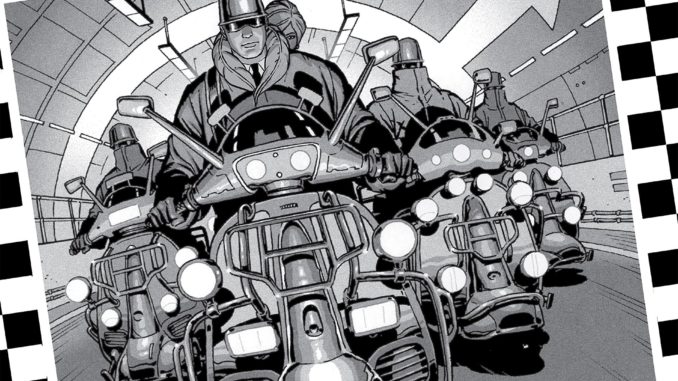
Do yourself a favor and read Dave Gibbons’ explanation of what it means to be ‘Mod’ before delving into his graphic novel ‘The Originals.’ The idea of a narrative about a sub-youth culture is not a new concept, yet Gibbons attempts to capture a moment colored by time. It’s his take on being young, in England and defining himself by the clothes he wore, the music he listened to and perceived enemies (the Greasers). Gibbons’ setup will remind you of Anthony Burgess’ ‘A Clockwork Orange’ where Burgess wrote about a group of marauding youths and their ring leader. Arguably Burgess’ novel was based on events that occurred after World War II, where groups of young people terrorized communities trying to rebuild their lives.
With a created language, and a protagonist with no redeeming qualities, Burgess spoke to a generation that was dealing with the idea of the power to choose. Choose how they would live their lives, and whether they would choose to stop being evil. For Gibbons his graphic novel is in spirit to the ‘Mod’ era. The reality is that this world is Gibbons own creation with a focus on young people at a crux in their lives.
Told in mostly black and white, ‘The Originals’ starts with Lel reminiscing about him and his Black friend Bok wanting to be Originals. He looks older and jaded, as if he’s mocking the notion of wanting to be unique. Flashing back he and Bok are about to make their mark on the world. They look young and arrogant. But at least they have their lives ahead of them. The group they idolize roll up on them. They’re an imposing bunch with long raincoats, tall biker-type hats and shades you can see your reflection in – and it’s nighttime. Essentially, they’re the cool guys and Lel and Bok want to be a part of them.
Interspersed throughout the story are music titles and news stories that foreshadow what’s going to occur next. Songs such as ‘The Writing’s on the Wall’ is both literal and metaphoric as we journey along with Lel and Bok and the other characters. You don’t quite know who to root for, but as you continue to read, perhaps that isn’t the point. Seen through Lel’s eyes he’s just a guy trying to belong, to fit in. Everyone wants to feel special and joining this group does that. But in a group you tend to lose your individuality. That thing that made you liked can easily be manipulated. Before you know it you’re doing things you didn’t realize were against your principles. What happens to these two young men will have you reflecting on what would you do to belong to something bigger than yourself. Mostly you’ll be looking at Lel. He becomes a product, a tool in several ways.
Gibbons halfway through this graphic novel gives you a false sense of a linear narrative. Instead, you get gut-punched. Lel’s so busy telling his story, about his girlfriend, his best friend and the jerky follower, that he doesn’t notice how they’ll look at him. The people who see them also have their own opinions. The cops see them as an annoyance, the rival crew always have a look of anger, resentment and jealousy. While the Originals are polished, the Dirt look like their name, unkempt and greasy. But it’s the average people around them. Gibbons has them wearily looking at these young people pretending at being men. Lel’s father barely looks up from his newspaper, grumbling about the youth of today. The adults don’t understand how kids who don’t have to fight a war create one.
‘The Originals’ has one bump in its telling in that there’s one character who takes the traditional route of being a plot device. Though they could be developed a bit more, this is Lel’s story, told from his perspective and everyone is in his peripheral. Like Lel, everyone’s a superstar in their own movie. Still, there’s a reason Gibbons is considered a giant in comics. The man who collaborated on the ‘Martha Washington’ comic book series and ‘Watchmen’ has created a story that starts out one way and ends up being a gnarly noir. You need this in your life.

Leave a Reply